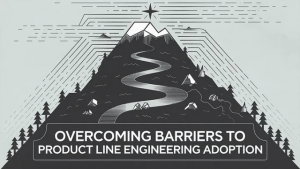Product Line Engineering — barriers to adoption and how and why to overcome them
Implementing tools like Pure Variants for product line engineering (PLE) can be challenging, but understanding the common barriers to adoption — and how to overcome 
Understanding the Complexity of PLE
Challenge: Product line engineering (PLE) may feel abstract and complex, making it difficult for teams to grasp its tangible benefits.
Approach: Begin with a foundational overview of PLE principles, relating them to specific challenges your organization faces. Examine case studies from your industry to see how others have approached PLE and benefitted from it.
Steps to Overcome:
— Step 1: Start with a pilot project that demonstrates how Pure Variants handles variability within one area of your product development.
— Step 2: Use the pilot to simplify and illustrate how PLE could integrate with and enhance your existing workflows.
Why it’s Worth It: pure::variants enables systematic management of product complexity, reducing development errors and ensuring consistency across product lines. Once teams grasp its value, PLE can greatly streamline engineering efforts.
Navigating Initial Investment and Change Management
Challenge: Implementing pure::variants requires upfront work to create variability models, train teams, and adapt workflows. This investment may seem high initially.
Approach: Break down the adoption process into manageable phases, each building on previous successes. Doing this allows your organization to see incremental progress and realize benefits along the way.
Steps to Overcome:
— Step 1: Begin with a small-scale implementation, applying pure::variants to a limited product set. This reduces risk and demonstrates value early on.
— Step 2: Introduce phased training, gradually building teams’ confidence and capability without overwhelming them.
Why it’s Worth It: Once in place, PLE standardizes processes, ultimately saving time and reducing errors. This can have lasting benefits for both the engineering process and overall productivity.
Establishing a Clear Return on Investment (ROI)
Challenge: PLE requires resources upfront, and organizations may hesitate if they don’t see a clear, rapid ROI.
Approach: Set realistic, measurable goals and focus on metrics that matter to your organization, such as reductions in development time, fewer production errors, or streamlined compliance processes.
Steps to Overcome:
— Step 1: Define performance metrics for each phase of implementation to show gradual improvement and early wins that lead to a larger return.
— Step 2: Use case studies of companies with similar product lines or configurations to understand expected ROI and establish a baseline for success.
Why it’s Worth It: Over time, Pure Variants allows for faster adaptation to market changes, reduced time-to-market, and more efficient product line management. Each of these gains adds to a compounding ROI that justifies the initial investment.
Visualizing Long-Term Benefits
Challenge: PLE’s benefits are not short-term, so some organizations may find it difficult to justify the investment without short-term wins.
Approach: Outline achievable goals that provide early gains alongside longer-term objectives to reinforce the value of PLE.
Steps to Overcome:
— Step 1: Set and track specific, realistic milestones, such as time saved on configuring product variants or improvements in compliance tracking.
— Step 2: Use a timeline to clarify when different types of ROI can be expected, ensuring teams know that benefits will accrue with each product cycle.
Why it’s Worth It: The rewards of implementing PLE include streamlined product lifecycle management, reduced maintenance costs, simplified regulatory compliance and a competitive advantage. A clear timeline can help everyone understand the sustained value PLE offers.
Addressing Integration and Compatibility Concerns
Challenge: Organizations may worry that pure::variants will disrupt existing tools or add complexity to product data management.
Approach: Assess Pure Variants’ integration capabilities, especially if you rely on tools like IBM DOORS or Rhapsody. Knowing it’s compatible with established systems eases concerns and can streamline workflows. Given the dozens of tool integrations available from Pure Variants this issue is easily solved for most organizations.
Steps to Overcome:
— Step 1: Engage in a technical review to ensure pure::variants aligns with your systems and can support your unique data flow.
— Step 2: Establish an integration roadmap with defined checkpoints, so any compatibility issues are anticipated and addressed.
Why it’s Worth It: Integrating Pure Variants simplifies managing configurations across product lines and helps reduce redundancies. It’s an investment that maximizes the value of your existing systems, making it easier to adapt to future changes.
321 Gang can help you to navigating the evaluation and adoption of Pure Variants and build a solid foundation for PLE, making it easier to manage complexity, drive efficiency, and ultimately achieve a sustainable, high-quality product lifecycle.
